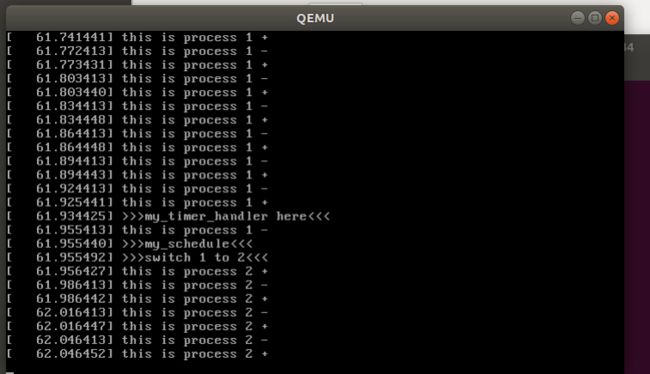1. 实验要求
·按照https://github.com/mengning/mykernel 的说明配置mykernel 2.0,熟悉Linux内核的编译。
·基于mykernel 2.0编写一个操作系统内核,参照https://github.com/mengning/mykernel 提供的范例代码。
·简要分析操作系统内核核心功能及运行工作机制。
2.实验环境
Ubuntu18.04物理机
3. 环境配置
1)在ubuntu的终端依次执行
wget https://raw.github.com/mengning/mykernel/master/mykernel-2.0_for_linux-5.4.34.patch sudo apt install axel axel -n 20 https://mirrors.edge.kernel.org/pub/linux/kernel/v5.x/linux-5.4.34.tar.xz xz -d linux-5.4.34.tar.xz tar -xvf linux-5.4.34.tar cd linux-5.4.34 patch -p1 < ../mykernel-2.0_for_linux-5.4.34.patch sudo apt install build-essential libncurses-dev bison flex libssl-dev libelf-dev make defconfig # Default configuration is based on 'x86_64_defconfig' # 使用allnoconfig编译出来qemu无法加载启动,不知道为什么?有明白的告诉我,完整编译太慢了,消耗的资源也多。 make -j$(nproc) # 编译的时间比较久哦 sudo apt install qemu # install QEMU qemu-system-x86_64 -kernel arch/x86/boot/bzImage
2)配置结果
4. 代码分析
执行过程
首先调用调用my_start_kernel方法,该方法主要创建,初始化一些列进程,并启动0号进程。其中所创建的这些进程的ip都指向my_process方法,也就是说,当这些进程开始执行时,都会去执行my_process方法。my_process方法是每进过1000(可自行调节)个时钟中断并且i增加10000000,便会执行一次进程切换,用于模拟时间片轮转算法。
PCB结构体(进程控制块):对进程的调度本质上是对进程控制块进行操作。进程控制块中封装有进程id,进程状态,进程的堆栈信息,代码入口ip,sp。在本实验中,我们使用的是一个pcb链表来管理进程的pcb。本实验中,进程的状态有三种unrunnable, runnable, stopped。pcb.h代码如下:
typedef struct PCB{
int pid;
volatile long state; /* -1 unrunnable, 0 runnable, >0 stopped */
unsigned long stack[KERNEL_STACK_SIZE];
/* CPU-specific state of this task */
struct Thread thread;
unsigned long task_entry;
struct PCB *next;
}tPCB;
My_start_kernel:这里是mykernel内核代码的入口,负责初始化内核的各个组成部分(见注释)。
void __init my_start_kernel(void)
{
int pid = 0;
int i;
// 初始化进程0
/* Initialize process 0*/
task[pid].pid = pid;
task[pid].state = 0;/* -1 unrunnable, 0 runnable, >0 stopped */
// 0号进程的ip指向my_process程序位置
task[pid].task_entry = task[pid].thread.ip = (unsigned long)my_process;
task[pid].thread.sp = (unsigned long)&task[pid].stack[KERNEL_STACK_SIZE-1];
task[pid].next = &task[pid];
/*fork more process */
for(i=1;i
my_process:用来作为进程的代码,模拟时间片轮转。
// 该程序用来作为进程的代码,模拟一个进程,当进程运行完一个时间片后主动让出CPU的方式。
void my_process(void)
{
while(1)
{
i++;
// 每经过10000000累加,以及当my_need_sched为1时,进程进行切换。
if(i%10000000 == 0)
{
printk(KERN_NOTICE "this is process %d -\n",my_current_task->pid);
if(my_need_sched == 1)
{
my_need_sched = 0;
my_schedule();
}
printk(KERN_NOTICE "this is process %d +\n",my_current_task->pid);
}
}
}
My_timer_handler:时钟中断处理过程,每一次时钟中断,time_count加一。如果time_count%==0,则将my_need_sched设置为1,表明当前需要进行进程调度。
/*
* Called by timer interrupt.
* it runs in the name of current running process,
* so it use kernel stack of current running process
*/
void my_timer_handler(void)
{
if(time_count%1000 == 0 && my_need_sched != 1)
{
printk(KERN_NOTICE ">>>my_timer_handler here<<<\n");
my_need_sched = 1;
}
time_count ++ ;
return;
}
my_schedule:用于进程切换,主要功能有保存当前进程的上下文,恢复待调度进程的上下文,并将控制权移交给待调度进程(见代码注释)。
// 进程切换
void my_schedule(void)
{
tPCB * next;
tPCB * prev;
// 如果当前进程pcb为空,或者当前进程的下一个pcb为空,则返回
if(my_current_task == NULL
|| my_current_task->next == NULL)
{
return;
}
printk(KERN_NOTICE ">>>my_schedule<<<\n");
/* schedule */
// next指向需要切换的进程,也就是当前进程的下一个进程
// prev指向的是当前进程
next = my_current_task->next;
prev = my_current_task;
// 如果下一个进程的状态为可运行状态,方可执行切换
if(next->state == 0)/* -1 unrunnable, 0 runnable, >0 stopped */
{
// 此处执行进程切换
my_current_task = next;
printk(KERN_NOTICE ">>>switch %d to %d<<<\n",prev->pid,next->pid);
// 保存之前进程的上下文,恢复待切换进程的上下文
/* switch to next process */
asm volatile(
"pushq %%rbp\n\t" /* save rbp of prev */
"movq %%rsp,%0\n\t" /* save rsp of prev */
"movq %2,%%rsp\n\t" /* restore rsp of next */
"movq $1f,%1\n\t" /* save rip of prev */
"pushq %3\n\t"
"ret\n\t" /* restore rip of next */
"1:\t" /* next process start here */
"popq %%rbp\n\t"
: "=m" (prev->thread.sp),"=m" (prev->thread.ip)
: "m" (next->thread.sp),"m" (next->thread.ip)
);
}
return;
}
5. 运行结果

